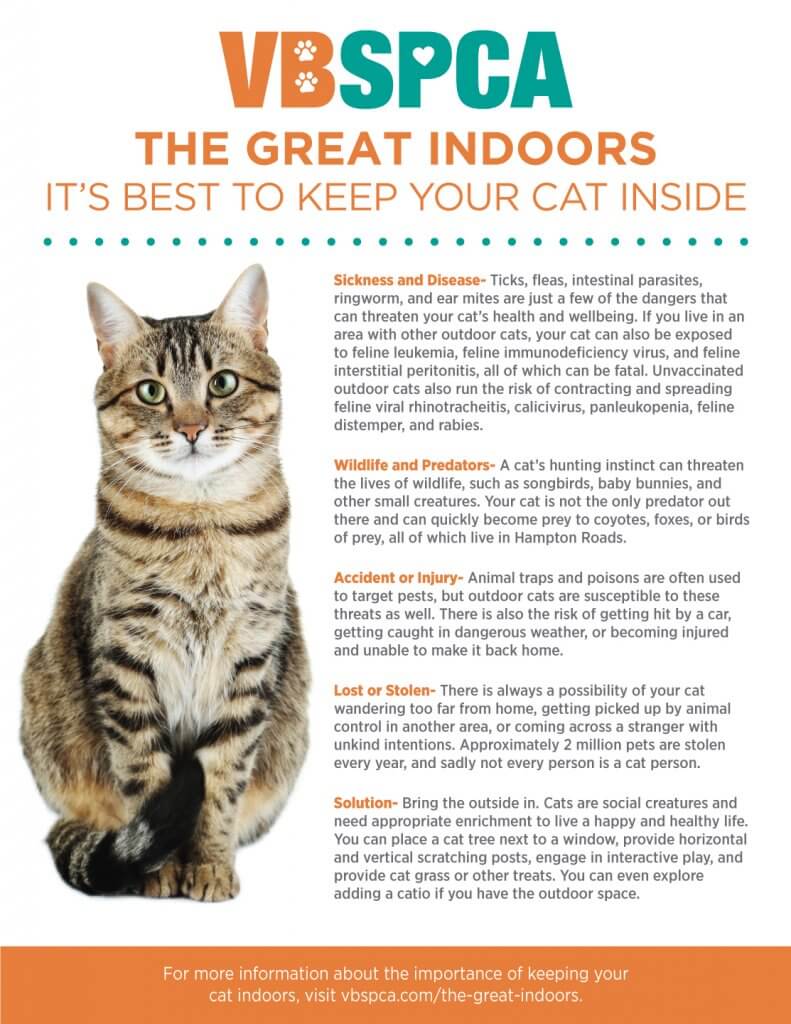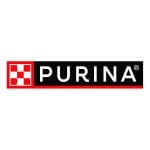Cats are natural hunters. They’ve evolved from helping control pests on ships and farms to slowly becoming domesticated companions in our homes. Domesticated cats exercise their hunting instincts through play, finding food in the bowls we fill for them, chasing red lasers, or sneaking up on your ankles from across the room. However, as much as they pounce and play, cats also embody a sense of independence that is quite the opposite of their canine counterparts. But this air of independence can be misleading, because domesticated cats rely on us for their safety and wellbeing, despite their self-sufficient stereotype.
Help practice responsible pet ownership by keeping your cat indoors and not allowing your cat to roam outside. You may feel that a life inside is too restrictive for your little hunter, but indoor cats can live up to 6 times longer than outdoor cats, which makes keeping your cat indoors the best choice if you want to share a long life with your feline friend.
Not convinced? Here are a few more reasons why living indoors is a a safer and healthier option for your cat.
Sickness and disease.
Indoor cats are not exposed to parasites and other communicable diseases to which outdoor cats are susceptible. Ticks, fleas, intestinal parasites, ringworm, and ear mites are just a few of the dangers that can threaten your cat’s health and wellbeing. However, these dangers don’t just threaten your cat, your cat’s exposure to them can threaten other animals in your home, including you. If you live in an area with other outdoor cats, your cat can be exposed to the many contagious diseases among felines, such as feline leukemia (FeLV), feline immunodeficiency virus (FIV), and feline interstitial peritonitis (FIP), all of which can be fatal. Unvaccinated outdoor cats also run the risk of contracting and spreading feline viral rhinotracheitis (herpesvirus), calicivirus, panleukopenia, or feline distemper. And that’s just between cats. Other animals outdoor cats will come across exposes them to many more diseases and deadly viruses, like rabies.
Wildlife and Predators.
A cat’s hunting instinct can threaten the lives of wildlife, such as songbirds, baby bunnies, and other small creatures. As proud as your cat may be to have captured her prey, you may not be as thrilled to receive these special “gifts.” Furthermore, interactions with local wildlife can also risk injury and infection, which may not be easy to spot right away. Plus, your cat is not the only predator out there and can quickly become prey to coyotes, foxes, or birds of prey, all of which live in Hampton Roads.
Accident or Injury.
Animal traps and poisons are often used to target pests, but outdoor cats are susceptible to these threats as well. There is also the risk of getting hit by a car, which can happen in both urban areas and on country roads. A free roaming cat can also get caught in dangerous weather conditions, access poison or toxic substances, or become injured and physically unable to make it back home.
Lost or Stolen.
No matter how “street-smart” your cat may be, there is always a possibility of your cat wandering too far from home, getting picked up by animal control in another area, or coming across a stranger with unkind intentions. Approximately 2 million pets are stolen every year, and sadly not every person is a cat person.
Solution: Bring the outside in
Cats are still social creatures and need appropriate enrichment to live a happy and healthy life. Here are a few things you can do to make sure your cat is getting the enrichment needed to be safe and happy.
- Put a cat tree by a window so they can view the great outdoors while remaining safely inside.
- Create multiple levels of perches for jumping and exercising inside.
- Set up a spot with cat grass and other treats, as well as different textures for your cat to enjoy.
- Use both horizontal and vertical cat scratchers.
- Engage in interactive play using wands and laser toys as a wonderful way to provide the mental and physical exercise your cat needs. Interactive play is also a great method for redirection if your cat seems too focused on going outside.
- Use puzzle toys, so your cat can treasure hunt for treats.
If your cat absolutely needs time outside, consider a “catio” or secure outdoor enclosure. If you don’t have the time or space for a catio, you can take steps to get your cat used to a harness and take your cat on a walk!





Last Updated: June 21, 2018 by vbspcaadmin
Puttin’ for Paws
Grab your friends and hit the links at Greenbrier Country Club on August 17th for a day of fun at our annual golf tournament, Puttin’ for Paws. This tournament features great raffles, hole-in-one prizes, a delicious dinner, and awards for our top players.
And, of course some meet and greet time with adoptable animals!
11:00 AM – Registration & Range Open
12:00 PM – Shotgun Start
$500 Foursome | $150 Individual Player
All Registrations Include:
Cart Rental and Range Balls
Lunch & Unlimited Beverages
Ditty Bags
Awards Dinner
If you would like to become a sponsor or register a team, contact April Le or Emily Peck at events@vbspca.com or call 757-427-0070 ext. 145. You may also register online at www.vbspca.com/golf.
Sponsorship Deadline – July 27th | Registration Deadline – August 3rd
Questions? Contact us at events@vbspca.com
Last Updated: May 26, 2022 by vbspcaadmin
What is Catnip and Why do Cats Love it?
June 15th is World Catnip Awareness Day! If you would like to donate catnip or catnip products to our shelter cats, please drop off any donations to our shelter on Holland Road. Your donation will offer added enrichment to the lives of shelter cats who are patiently waiting for their forever homes. June is also Adopt-A-Shelter Cat Month, so stop by our cattery while you’re here and visit with some of our furry friends.
In the meantime, we thought we would celebrate World Catnip Awareness Day by sharing some fun facts about this feline treat:
The Virginia SPCA carries a variety of catnip toys for your feline friends at home! Below are some of our staff favorites.
VBSPCA Recommended Catnip Products:
Kong Naturals Catnip Spray
Fat Cat Boogie Mat
Yeowww! Organic Catnip (Loose catnip)
PetStages Easy Life Scratch, Snuggle & Rest
Yeowww! Catnip Toys: Apple, Banana, Pollock Fish & Rainbow
You can directly help homeless animals in our community by purchasing your catnip items and other pet products at the VBSPCA Shelter. Thank you for your support.
Last Updated: May 26, 2022 by vbspcaadmin
Traveling with your Four-Legged Friend
June through August is peak travel season, and while you’re brimming with excitement over your summer vacation, your pet might not be as thrilled. The good news is that more and more Americans are traveling with pets, so if leaving your pet behind causes anxiety for you or your furry friend, traveling together is an option. Keep the following tips in mind if you plan to bring your pet along on your next adventure:
Bon Voyage and best wishes for happy trails!
Last Updated: December 17, 2018 by vbspcaadmin
Tips from our Trainer: Master the Dog Walk
A tired dog is a well-behaved dog, but physical activity alone isn’t enough to stave off the side effects of dog boredom. Your dog needs consistent mental activity to remain engaged, and a daily walk is the perfect opportunity to provide your pet with a mental reboot. Add these easy tips to your daily routine for high quality walks your dog will love:
Reduce leash pulling by letting your dog exert some physical energy before the walk. 15 minutes of playing fetch or tug can remove pent up excitement. If your dog still pulls once you start the walk, don’t pull or yank back. This just gives your pet more incentive to pull. We recommend keeping high value treats in your pocket to help lure your dog’s attention back to you. Once your dog has returned to your side, reward him.
Practice makes perfect. Practice walking your dog in the house, backyard, front yard, or other areas that have fewer distractions. You want your dog to get in the habit of walking by your side and not running off after every sound, sight, or smell. Use high value treats as a reward for walking by your side, and use verbal praise and a training clicker to validate good leash behavior.
Your dog was born with a powerful sense of smell for a reason, and this means you need to provide your pet with opportunities to sniff and explore. However, letting your dog’s nose lead the way for the entire walk could negate any previous leash training. Offer intermittent sniff and bathroom breaks, and make sure to reward your dog for staying focused on you.
Before heading out, check to be sure your dog’s identification tags are secure and remember to always bring water, treats, and waste bags on your dog walk. For additional training fun and a full schedule of training classes and programs, visit the Happy Paws website at happypawstraining.org.
Last Updated: February 23, 2021 by vbspcaadmin
The Great Indoors
Cats are natural hunters. They’ve evolved from helping control pests on ships and farms to slowly becoming domesticated companions in our homes. Domesticated cats exercise their hunting instincts through play, finding food in the bowls we fill for them, chasing red lasers, or sneaking up on your ankles from across the room. However, as much as they pounce and play, cats also embody a sense of independence that is quite the opposite of their canine counterparts. But this air of independence can be misleading, because domesticated cats rely on us for their safety and wellbeing, despite their self-sufficient stereotype.
Help practice responsible pet ownership by keeping your cat indoors and not allowing your cat to roam outside. You may feel that a life inside is too restrictive for your little hunter, but indoor cats can live up to 6 times longer than outdoor cats, which makes keeping your cat indoors the best choice if you want to share a long life with your feline friend.
Not convinced? Here are a few more reasons why living indoors is a a safer and healthier option for your cat.
Sickness and disease.
Indoor cats are not exposed to parasites and other communicable diseases to which outdoor cats are susceptible. Ticks, fleas, intestinal parasites, ringworm, and ear mites are just a few of the dangers that can threaten your cat’s health and wellbeing. However, these dangers don’t just threaten your cat, your cat’s exposure to them can threaten other animals in your home, including you. If you live in an area with other outdoor cats, your cat can be exposed to the many contagious diseases among felines, such as feline leukemia (FeLV), feline immunodeficiency virus (FIV), and feline interstitial peritonitis (FIP), all of which can be fatal. Unvaccinated outdoor cats also run the risk of contracting and spreading feline viral rhinotracheitis (herpesvirus), calicivirus, panleukopenia, or feline distemper. And that’s just between cats. Other animals outdoor cats will come across exposes them to many more diseases and deadly viruses, like rabies.
Wildlife and Predators.
A cat’s hunting instinct can threaten the lives of wildlife, such as songbirds, baby bunnies, and other small creatures. As proud as your cat may be to have captured her prey, you may not be as thrilled to receive these special “gifts.” Furthermore, interactions with local wildlife can also risk injury and infection, which may not be easy to spot right away. Plus, your cat is not the only predator out there and can quickly become prey to coyotes, foxes, or birds of prey, all of which live in Hampton Roads.
Accident or Injury.
Animal traps and poisons are often used to target pests, but outdoor cats are susceptible to these threats as well. There is also the risk of getting hit by a car, which can happen in both urban areas and on country roads. A free roaming cat can also get caught in dangerous weather conditions, access poison or toxic substances, or become injured and physically unable to make it back home.
Lost or Stolen.
No matter how “street-smart” your cat may be, there is always a possibility of your cat wandering too far from home, getting picked up by animal control in another area, or coming across a stranger with unkind intentions. Approximately 2 million pets are stolen every year, and sadly not every person is a cat person.
Solution: Bring the outside in
Cats are still social creatures and need appropriate enrichment to live a happy and healthy life. Here are a few things you can do to make sure your cat is getting the enrichment needed to be safe and happy.
If your cat absolutely needs time outside, consider a “catio” or secure outdoor enclosure. If you don’t have the time or space for a catio, you can take steps to get your cat used to a harness and take your cat on a walk!
Last Updated: July 19, 2018 by vbspcaadmin
Mutt Masquerade
SAVE THE DATE!
Our annual Mutt Masquerade 5K & 1 Mile Walk will be held on Sunday, October 28th, 2018 at the 24th street beach park at the Virginia Beach oceanfront.
Last Updated: July 19, 2018 by vbspcaadmin
Annual Gala
Thank you to everyone who joined us for the Virginia Beach SPCA Western Wags and Whiskers, Howl at the Moon Gala on March 24th, 2018, for a beautiful evening at the Cavalier Golf & Yacht Club.
We would like to thank all of our sponsors including the DeCroix Family Foundation, Givens, The Franklin Johnston Group, New Amsterdam Vodka, McWaters Family Foundation, Old Point National Bank, Troutman Sanders, Exit Realty, Williams Mullen, Priority Automotive, Teide Enterprises, Taylor’s Do It Center, Atlantic Heating & Cooling, Creech Insurance, Merck Animal Health, Davis Ad Agency, C & M Industries, Armada Hoffler Properties, The Pet Loss Center, Davenport Asset Management, Core Assurance, Towne Bank, Morris & Jan Fine, Dave & Mickey Jester, James Somers, and Bruce L. Thompson.
Thank you to our Master of Ceremonies, Allen Fabijan.
We look forward to seeing you at the 2019 Gala! Contact the Development Office at events@vbspca.com for questions.
Photos and program videos from the 2018 VBSPCA Western Wags and Whiskers Gala can be found at the links below. Photographs are available for purchase. 50% of proceeds will be donated to the Virginia Beach SPCA.
Don Monteaux Photography
VBSPCA 2018 Mission Video
2018 Lifesaver Award Jane Smith Wolcott
Painting with Pets
Search
Ways to Give
Annual Partners
To view our Donor Privacy Policy, click here.